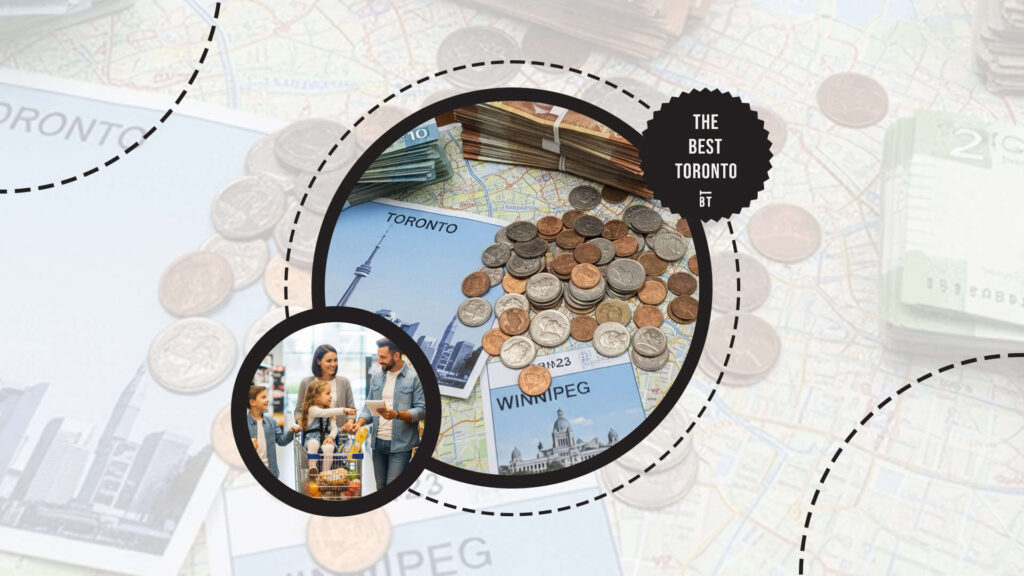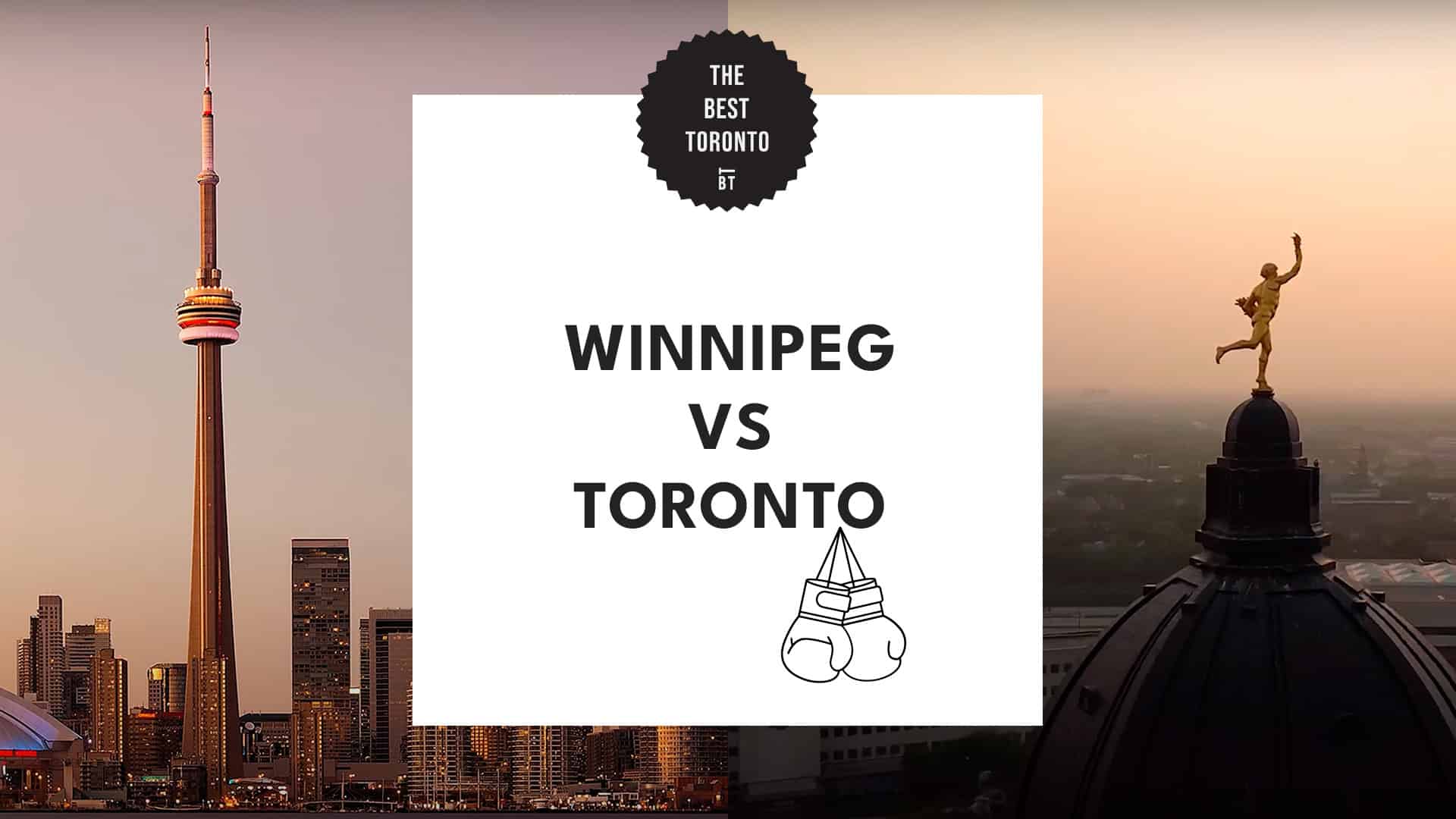Big city lights or prairie nights? Should you settle in Winnipeg or Toronto?
Winnipeg and Toronto—two iconic Canadian cities with completely different vibes. If you’re deciding where to plant your roots, the better choice depends on what you value most in a city.
If you value cultural diversity, job opportunities, and world-class amenities, Toronto edges ahead. But if you crave affordability, community spirit, and a slower pace, Winnipeg might be your winner.
In this face-off, we’ll dig into everything, from cost of living and lifestyle to weather and culture—giving you the inside scoop so you can pick your forever home.
Cost of Living in Winnipeg vs. Toronto

| The cost of living in Toronto is $78.40 higher than in Winnipeg. A single person in Toronto spends about $1,120.90 per month compared to $1,042.50 in Winnipeg. |
Before you pack your bags, it’s worth seeing how much everyday life will cost you in each city.
Toronto is Canada’s largest and most expensive city, offering global job markets and a diverse culture—but at a price. Meanwhile, Winnipeg has a lower cost of living and a slower pace, perfect for families and those wanting more financial breathing room.
Below is a simplified comparison based on Numbeo.com that shows just how big the gap can be between these two urban centers. The table focuses on essentials, so you can get a clear picture without being buried in data.
| Category | Winnipeg | Toronto |
| Rent Prices | $1301 (1-bed, city center) | $2460 (1-bed, city center) |
| Restaurant Meal | $22 | $25.33 |
| Average Grocery Basket | $5.69 per item | $6.92 per item |
| Transportation (Monthly Transit Pass) | $115 | $156 |
| Utilities (Monthly) | $203 (basic utilities) | $171 (basic utilities) |
| Sports & Leisure | $56 | $77 |
| Childcare | $1348 | $1489 |
The most striking difference is in housing. Rent in Toronto is almost twice as high as in Winnipeg, making it the single biggest driver of the cost gap.
Food and dining also cost more in Toronto, although the difference is smaller. Restaurant meals are about $14 pricier, and groceries are about 5% more expensive—though some individual items vary widely.
As a whole, you’d need almost $1800 more each month to maintain the same standard of living in Toronto as in Winnipeg. This difference is worth weighing carefully if you’re deciding where to live.
Real Estate Prices in Winnipeg vs. Toronto

| Toronto has significantly higher real estate prices compared to Winnipeg, with a two-story single-family home costing $1,396,100, compared to $355,300 in the Peg. That’s a huge difference of $1,040,800. |
If you’re planning on buying and not renting, housing prices can be one of the biggest deciding factors between Winnipeg and Toronto.
Toronto’s real estate market is famously pricey, driven by high demand and limited supply. Winnipeg, on the other hand, offers more affordable entry points for almost every type of property.
Based on data from CIC News, here’s a simple breakdown comparing typical benchmark prices for popular housing types in Winnipeg and Toronto:
| Property Type | Winnipeg | Toronto |
| One-Story Single-Family Home | $422,900 | $1,106,100 |
| Two-Story Single-Family Home | $355,300 | $1,396,100 |
| Townhouse | $319,400 | $817,200 |
| Apartment | $226,000 | $679,200 |
In many cases, a home in Toronto costs more than double—sometimes nearly triple—what you’d pay for something similar in Winnipeg.
This means buyers in Winnipeg can often afford larger properties or better locations for the same budget that would buy a much smaller or older property in Toronto.
If owning a home is high on your priority list, the numbers suggest Winnipeg could be the more achievable choice. It’ll leave you more room in your budget for travel, savings, or other lifestyle perks.
Diversity and Demographics in Winnipeg vs. Toronto
| Toronto is one of the most multicultural cities in the world, with 57% of its residents identifying as visible minorities, as compared to Winnipeg’s 34.4%. On the other hand, Winnipeg stands out for its strong Indigenous presence, with 12.4% of residents identifying as Indigenous. |
Culture and community can be just as important as the cost of living when choosing a city. The people, traditions, and neighborhoods around you shape your daily life and sense of belonging.
Toronto attracts residents from every corner of the globe. This diversity is reflected in its dynamic neighborhoods (Little Italy, Koreatown, Little Jamaica, etc.).
Winnipeg is also diverse but has its own unique makeup, with a particularly strong Indigenous presence that shapes much of the city’s history and character.
Looking at side-by-side demographics sourced from Statistics Canada can help you decide which city’s cultural environment feels most like home:
| Category | Winnipeg | Toronto |
| Visible Minority Population | 34.4% | 57% |
| Indigenous Population | 12.4% | 0.7% |
| Notable Cultural Communities | Large Indigenous presence, Filipino, Ukrainian, Metis | Multiple Chinatowns, Little Italy, Little India, Greektown, Koreatown, Little Jamaica, Little Portugal, etc. |
| Multilingualism | English, French, Tagalog, Cree, Ojibwe | English, French, Mandarin, Cantonese, Punjabi, Italian, Portuguese, Greek, and more |
Toronto’s diversity is unmatched in Canada, with more than half of its residents identifying as a visible minority. This means a huge variety of cultural events, international cuisines, and globally connected communities.
Winnipeg is also multicultural, but it’s more known for its high proportion of Indigenous residents. This plays a central role in the city’s identity, politics, and arts scene.
Language diversity is more pronounced in Toronto due to the scale of immigration. Winnipeg’s multilingualism reflects both Indigenous languages and newer immigrant communities.
If you value being in a global hub with countless ethnic neighborhoods, Toronto may appeal to you. But if you’re drawn to a city with a strong Indigenous heritage and a smaller, close-knit multicultural community, Winnipeg could be a better fit.
Career Opportunities in Winnipeg vs.Toronto

| Toronto offers a higher average take-home monthly pay of $4,408.37 compared to Winnipeg’s $3,637.74, a difference of $770.63. Both cities provide strong regional opportunities. Winnipeg thrives in healthcare and manufacturing, while Toronto leads in tech, finance, and media. |
Toronto is home to Canada’s largest job market, attracting talent from around the globe. Comparatively, Winnipeg offers a more stable, locally driven economy with steady demand across multiple sectors.
Sourced from Numbeo.com and EDW, the table below compares average monthly net salaries, major industries, and other economic factors. These figures will help give you a quick snapshot of what each city offers.
| Category | Winnipeg | Toronto |
| Ave. Monthly Net Salary (After Tax) | $3,637.74 | $4,408.37 |
| Key Industries | Healthcare and social assistance, retail, manufacturing, public administration, logistics | Finance, technology, media, global business, healthcare |
| Major Employers | Manitoba Hydro, University of Manitoba, Government of Manitoba, New Flyer Industries | Royal Bank of Canada, TD Bank, Shopify, Rogers Communications, University of Toronto |
| Economic Development Initiatives | Economic Development Winnipeg promotes innovation, diverse hiring, and partnerships | Toronto Global attracts international investment, promotes tech and finance sectors |
Toronto offers an average monthly salary that’s about $770 higher than Winnipeg. For pros aiming to climb the ladder in high-paying fields such as finance, technology, or corporate leadership, Toronto generally provides more lucrative prospects.
As Canada’s largest economic hub, Toronto offers an unmatched variety of career opportunities. From multinational headquarters to cutting-edge startups, the city’s reach extends globally.
Winnipeg’s economy is built on a strong and diverse base, spanning healthcare, manufacturing, and logistics. Its position as home to Centreport Canada, the country’s largest inland port, gives it an edge in transportation, trade, and supply chain careers.
Through initiatives led by Economic Development Winnipeg, the city fosters collaboration between industries, educational institutions, and government. This support network helps fuel innovation and attract investment.
Crime and Safety in Winnipeg vs. Toronto
| Toronto has a lower crime index of 43.8 compared to Winnipeg’s 60.5, and it also has a Safety Score of 56.2 compared to Winnipeg’s 39.5. Overall, both sets of numbers have a 16.7 point difference, making Toronto a safer place to live. |
Both Winnipeg and Toronto are major Canadian cities, but their crime levels and safety perceptions differ significantly.
It’s important to remember that the crime indices below are based on residents’ perceptions and reported incidents—they might not tell the whole story. However, they can provide useful guidance when comparing potential places to live.
This comprehensive table summarizes recent data from Numbeo.com, highlighting where each city stands on different crime and safety factors.
| Category | Winnipeg | Toronto |
| Crime index | 60.53 | 43.75 |
| Safety scale | 39.47 | 56.25 |
| Level of crime | High (71.85) | Moderate (48.28) |
| Increase in crime for the past 3 years | High (76.83) | High (69.12) |
| Home broken into and things stolen | Moderate (52.64) | Low (36.68) |
| Mugged or robbed | Moderate (55.21) | Low (37.91) |
| Car stolen | Moderate (49.40) | Low (35.60) |
| Things from car stolen | High (66.07) | Moderate (43.24) |
| Attacked | Moderate (55.45) | Moderate (40.28) |
| Insulted | Moderate (54.90) | Moderate (44.06) |
| Attacked due to ethnicity, gender, or religion | Low (35.98) | Low (28.80) |
| Drug use/dealing | High (76.84) | Moderate (56.92) |
| Property crimes | High (70.51) | Moderate (49.00) |
| Violent crimes | High (63.67) | Moderate (45.68) |
| Corruption and bribery | Moderate (43.94) | Low (37.29) |
| Safety walking alone during daylight | High (61.18) | High (73.94) |
| Safety walking alone at night | Low (26.82) | Moderate (51.69) |
While both cities report common challenges, Winnipeg shows higher perceived crime rates in categories like property theft, violent crime, and drug-related issues. These contribute to its overall crime index of 60.53, which is significantly above Toronto.
Toronto’s lower crime numbers (43.75) and higher safety scale (56.25) suggest residents feel more secure in their daily routines. The city especially stands out for better nighttime safety and fewer worries about theft or car-related crimes.
That said, both cities still have safe neighborhoods and active community initiatives aimed at reducing crime. Winnipeg, for instance, has strong community policing and outreach programs that help foster safer areas.
Lifestyle in Winnipeg vs. Toronto

| Winnipeg is perfect if you enjoy a higher number of sunny days, local festivals, and a more relaxed pace. Meanwhile, if you prefer milder winters, a bustling cultural scene, and access to top-tier healthcare, Toronto might be the better fit. |
When weighing lifestyle differences between Winnipeg and Toronto, three key areas stand out: climate, things to do, and health care services.
Climate in Winnipeg vs. Toronto
The table below highlights key weather records and averages. These details reveal not only how hot or cold each city can get, but also how much rain or snow you might deal with over a year.
Weather Records and Averages: Winnipeg vs Toronto
| Metric | Winnipeg | Toronto |
| Record high | 42.2 °C | 40.6 °C |
| Record low | -47.8 °C | -32.8 °C |
| Most daily precipitation | 15.2 cm | 11 cm |
| Most monthly precipitation | 25.6 cm | 24.8 cm |
| Most yearly precipitation | 76.6 cm | 123.5 cm |
| Average yearly precipitation | 48.4 cm | 81.0 cm |
Maximum Difference Between High Temperatures
| Date | Winnipeg | Toronto |
| May 7, 1891 | 34.4 °C | 11.7 °C |
| Jan 25, 1950 | -27.8 °C | 15.6 °C |
The figures above show just how extreme Winnipeg’s climate can be. These sharp contrasts mean you’ll experience frigid winters and hot summers.
Toronto’s narrower temperature range offers a more moderate experience. Winters are significantly warmer on average, but summers can still get hot, though generally with more rainfall.
Precipitation patterns are another key difference—Winnipeg’s drier climate means fewer rainy days and more sunny ones. On the other hand, Toronto’s higher average yearly precipitation supports lusher greenery but also brings more wet commutes.
Ultimately, your comfort will depend on whether you thrive in a bright, crisp, cold, and dry environment or prefer a milder temperature paired with a wetter setting.
Things to Do in Winnipeg vs. Toronto
Winnipeg
Winnipeg hosts well-known festivals like the Winnipeg Folk Festival, held each July, which draws music lovers across the country. The Winnipeg Fringe Theatre Festival also brings the community together to celebrate the performing arts.
Nature lovers can enjoy Bois-des-Esprits, Assiniboine Park, and Birds Hill Provincial Park. In the coldest months, locals gather for winter fun at the Forks, where the river freezes into one of the world’s longest skating trails.
In terms of the food scene, Winnipeg leans more toward comfort food rooted in its prairie heritage, from Ukrainian perogies to Indigenous bannock tacos. At the market, you’ll find plenty of fresh, local produce from Manitoba farms.
Toronto
In Toronto, festival-goers can enjoy an even larger lineup from the Toronto International Film Festival to Nuit Blanche. Other major events include Caribana and Hot Docs, perfect for film, culture, music, and food lovers.
Toronto’s green spaces are more diverse, from urban gems like High Park and Allan Gardens to the gorgeous Scarborough Bluffs. In winter, the 6ix swaps summer patios for outdoor skating rinks and cozy holiday markets.
TO’s cuisine is far more international and fast-paced than Winnipeg’s; dining here feels like taking a delicious trip around the globe. You can sample dim sum in Chinatown, jerk chicken in Little Jamaica, and pasta in Little Italy—all in a single day!
Healthcare in Winnipeg vs. Toronto
Healthcare Satisfaction
Here’s a side-by-side look at healthcare satisfaction in both cities, according to data from Numbeo.com:
| Healthcare component surveyed | Winnipeg Rating | Winnipeg Satisfaction | Toronto Rating | Toronto Satisfaction |
| Medical staff skill & competency | High | 70.25% | High | 73.84% |
| Speed in completing examinations and reports | Moderate | 53.78% | High | 62.60% |
| Equipment for modern diagnosis & treatment | High | 79.62% | Very High | 83.15% |
| Accuracy & completeness in filling out reports | High | 70.39% | High | 76.42% |
| Friendliness & courtesy of staff | High | 71.64% | High | 74.12% |
| Satisfaction with responsiveness (waiting times) | Low | 31.04% | Moderate | 47.60% |
| Satisfaction with cost to you | Very High | 81.82% | Very High | 83.33% |
| Convenience of location for you | High | 72.95% | Very High | 81.16% |
Looking at the poll results, Toronto wins in almost every category, particularly in speed of service, access to modern facilities, and ease of reaching healthcare providers.
Winnipeg’s lower responsiveness core reflects longer wait times, but it still maintains strong ratings in staff friendliness and cost satisfaction.
Healthcare Facilities
Winnipeg is home to major institutions such as the Health Sciences Centre, one of Canada’s largest tertiary teaching hospitals. It operates under WRHA, which runs numerous community clinics, hospitals, and specialized programs.
In Toronto, you’ll have access to high-profile facilities such as Toronto General Hospital, Sunnybrook Health Sciences Centre, Mount Sinai, and SickKids. These are supported by a web of family physicians, walk-in clinics, and programs like Telehealth Ontario.
Healthcare Coverage
OHIP in Ontario provides Toronto residents with comprehensive access to doctor visits, hospitalizations, surgeries, and diagnostic testing without direct fees. Gaps like out-of-hospital prescriptions or dental visits are often manageable.
In contrast, Manitoba Health gives Winnipeggers basic coverage, including surgeries and urgent care, supplemented by Pharmacare for medication support. The regional structure through WRHA offers strong community and specialty healthcare.
Winnipeg vs. Toronto: The Final Verdict
As a whole, Winnipeg and Toronto each bring unique strengths and challenges to the table, making the “better city” a matter of personal priorities.
To tie everything together, here’s a quick summary of what we’ve covered:
| Factor | The Better City | Why |
| Cost of Living | Winnipeg | Winnipeg generally offers more affordable housing and day-to-day expenses. |
| Real Estate | Winnipeg | Home prices in Winnipeg are significantly lower. |
| Diversity & Demographics | Toronto | TO has a more globally diverse population. |
| Career Opportunities | Toronto | Toronto’s larger economy provides broader job opportunities. |
| Crime & Safety | Toronto | Perceptions of safety are higher in Toronto. |
| Weather | Toronto | Winters are milder in Toronto, while Winnipeg experiences harsher cold and longer snowy seasons. |
| Leisure | Tied (depends on preference) | Winnipeg offers a community-oriented vibe with lots of outdoor fun, while Toronto buzzes with global energy, diverse dining, and cultural life. |
| Healthcare | Toronto | Toronto generally provides faster access to services. |


